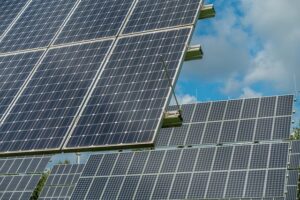
Harnessing the Sun: The Future of Solar Panels
As the world grapples with the pressing challenges of climate change, energy demand, and dwindling fossil fuel reserves, the spotlight increasingly falls on renewable energy sources. Among these, solar energy stands out as a beacon of hope. In recent years, solar panels have evolved drastically, propelling a revolution in sustainable energy. In this article, we will explore the future of solar panels, their technological advancements, economic implications, environmental impact, and what lies ahead for this shining segment of renewable energy.
The Rise of Solar Energy
Solar energy is harvested from the sun’s rays, which can be converted into electricity or heat. This clean energy source is abundant and inexhaustible, making it an attractive alternative to fossil fuels. The initial concepts of solar technology date back to the 1830s, but it wasn’t until the mid-20th century that practical solar panels were developed for energy conversion. The pace of innovation has accelerated dramatically in the last two decades, leading us to a point where solar technology is not only accessible but also essential for a sustainable future.
Technological Advancements in Solar Panels
Innovations in solar panel technology have revolutionized how we harness solar energy. Traditional silicon-based panels have given way to a variety of materials and techniques that enhance efficiency and reduce costs.
Perovskite Solar Cells
One of the most exciting developments in solar technology is the advent of perovskite solar cells. These cells utilize a specific crystal structure that allows for higher efficiency rates than traditional silicon panels. Research has shown that perovskite cells can achieve efficiencies exceeding 25%, significantly higher than their silicon counterparts. They are cheaper to produce and can be fabricated using less energy, making them promising candidates for widespread adoption.
Bifacial Solar Panels
Bifacial solar panels are another innovation designed to harness more sunlight. Unlike traditional panels that absorb light from only one side, bifacial panels can capture sunlight on both sides. This means they can generate additional electricity from reflected light on the ground, enhancing overall efficiency. Many solar farms are beginning to incorporate bifacial technology to maximize energy output.
Building-Integrated Photovoltaics (BIPV)
As urban spaces grow and the demand for land increases, the concept of Building-Integrated Photovoltaics (BIPV) has come into play. BIPV technology allows solar panels to be integrated into building materials such as windows and rooftops, serving a dual purpose of power generation and structural functionality. This approach not only maximizes space but also transforms the aesthetic of buildings while promoting energy efficiency.
The Economic Landscape of Solar Energy
The economic implications of expanding solar energy are profound. The installation and maintenance of solar panels create jobs, stimulate local economies, and reduce dependence on imported fossil fuels. As technology improves and production scales up, the cost of solar panels has decreased dramatically. This decline in costs has made solar energy more accessible to homeowners, businesses, and governments alike.
Government Policies and Incentives
Supportive government policies play a crucial role in the growth of solar energy. Subsidies, tax incentives, and rebates encourage the adoption of solar technology. In many countries, feed-in tariffs guarantee a fixed price for electricity generated from solar panels, which makes investing in solar energy more attractive for consumers. As global markets continue to shift towards sustainable practices, governments will need to adjust policies to support the growth of solar energy further.
The Role of Corporations
Corporations are increasingly recognizing the potential of solar energy not only for sustainability but also for economic efficiency. Major companies are investing in large-scale solar farms or integrating solar technology into their operations to reduce energy costs. As corporate social responsibility becomes a central focus, companies prioritizing renewable energy sources like solar power enhance their reputations and attract eco-conscious customers.
Environmental Impact and Sustainability
Solar energy presents a significant opportunity to mitigate the effects of climate change. By reducing reliance on fossil fuels, which are the primary contributors to greenhouse gas emissions, solar energy can help achieve global sustainability goals. The benefits extend beyond energy generation, as solar panels often require less water and produce no harmful emissions during operation.
End-of-Life Recycling and Sustainability Concerns
While the benefits of solar panels are evident, it is essential to address sustainability at all phases of their lifecycle, including end-of-life management. As solar technology matures, so does the need for effective recycling methods for decommissioned panels. Current research focuses on creating efficient systems for recovering valuable materials such as silicon, silver, and other rare metals to minimize waste and reduce the environmental impact of solar technology. Initiatives aimed at developing regulatory frameworks for recycling and disposal will further ensure that solar energy remains sustainable throughout its entire lifecycle.
The Future Outlook for Solar Panels
As we look to the future, several trends indicate that solar technology will continue to evolve rapidly. Innovations in energy storage systems, such as batteries, will complement solar energy generation, solving the intermittent nature of solar power. Furthermore, advancements in artificial intelligence and data analytics will optimize energy production, distribution, and consumption in smart homes and cities.
Grid Integration and Microgrids
With an increasing number of solar installations, the integration of solar energy into existing power grids will become crucial. Microgrids, which operate independently of the main grid, offer a solution by enabling localized energy generation and distribution. Communities can harness solar energy locally, enhancing resilience and reducing transmission losses associated with long-distance energy transport. This dynamic shift in how energy is produced and consumed has the potential to transform the overall energy landscape.
Global Energy Equity
Finally, the future of solar panels holds promise for enhancing global energy equity. In many developing regions, access to reliable energy remains a challenge. Portable and affordable solar technologies can empower communities with clean electricity, fostering economic growth while reducing reliance on unsustainable energy sources. Initiatives aimed at promoting solar solutions in off-grid areas are paving the way for a more equitable and sustainable global energy future.
Conclusion
The future of solar panels is bright, with promising advancements on the horizon. As technology continues to evolve and costs decline, solar energy stands poised to play a transformative role in the global energy landscape. The combined efforts of governments, corporations, and communities will be instrumental in harnessing the sun’s power effectively and sustainably. By embracing solar energy as a cornerstone of our energy future, we can move towards a cleaner and more sustainable world, ensuring that future generations inherit a planet that thrives on renewable resources.



